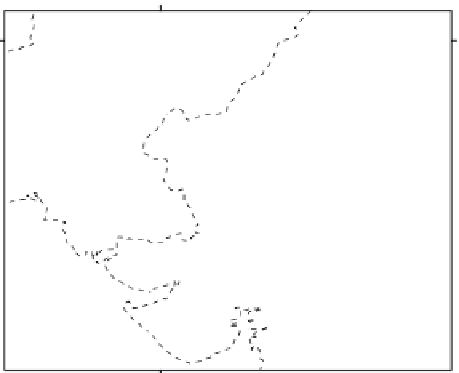Environmental Engineering Reference
In-Depth Information
70°0'0"E
Pakistan
30°0'0"N
30°0'0"N
Thar Desert
Jodhpur
Hyderabad
Karachi
Ahmadabad
Indian
Ocean
India
70°0'0"E
FIGURE 1.9
Map of the Thar Desert in India.
desert conditions are not especially extreme, for only locally does mean annual precipitation
fall below 4 in. The southwest monsoon manages to produce summer rainfall in the area,
and rural population densities are quite high. In the driest parts of the area, in the west, the
Indus and its tributaries are through-flowing rivers that are now much used for irrigation.*
An important feature of the Great Indian Desert is the presence of the snow-fed Indus
and its tributaries, both past and present. The discharge pattern is highly seasonal, and
floods can be very destructive. Its average annual flow is about twice that of the Nile, and
during floods, the river in the plains of Sind can be over 10 miles wide. The river carries
a huge sediment load, so that the Indus Delta is thought to have extended 50 miles in the
past 2000 years, and some 32 ft of aggradation has taken place in the past 5000 years.
49
However, perhaps, the most interesting hydrological features of the Thar rivers are their
propensity to change course or to disappear and the history of competition between the
Ganga and Indus systems in the northern Punjab. Ancient river courses of different ages
have been located,
50
and the geomorphology of ancient Indus courses in the Thal
doab
(between Chenab and Indus) has been described elsewhere.
51
Another distinctive feature of the Thar is the nature of its dunes. The coastline of the
Arabian Sea, the alluvial plain of the Indus, and the weathering of widespread outcrops
of sandstones and granites provide plentiful sand for aeolian reworking. The dominant
sand-moving winds come from the southwest, and this accounts for both the long-
distance transport of
foraminiferal tests
†
from the coast and for the overall alignments of
the dunes.
52
In the coastal regions of Saurashtra and Kutch, the dunes are composed of
calcareous aeolianites
, which are locally called miliolites,
53
but as one moves inland they
become generally
quartzose
. The general pattern of the dunes has been mapped, and the
particular importance of clustered parabolics of rake-like form in much of the desert was
emphasized.
54
This may reflect the relatively high rainfall levels with the concomitantly
relatively dense vegetation cover or it may be one response to the fact that, in terms of
*
General background information on the Indian Deserts is provided by B. Allchin et al.
48
†
Foraminiferal tests are shells of foraminifera, a group of marine organisms. Calcareous aeolianites are wind-
blown sediments cemented with calcium carbonate. Quartzose deposits mostly contain particles of quartz.
Sayf dunes are longitudinal dunes that are parallel to wind direction.





Search WWH ::

Custom Search